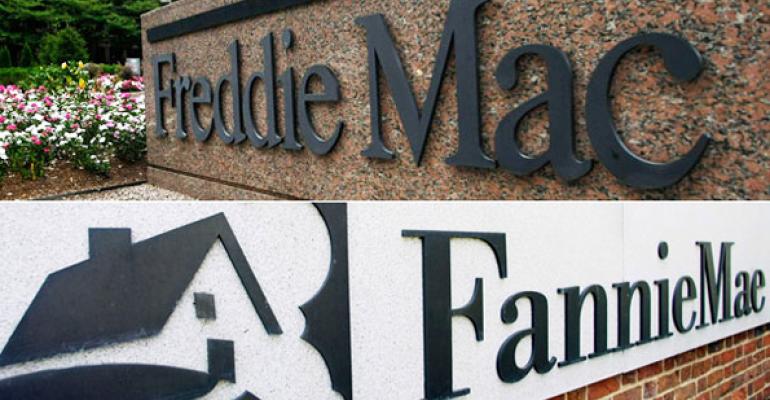Apartment property owners still look to the lending programs of Fannie Mae and Freddie Mac when they need permanent financing.
“Freddie and Fannie are again the number one multifamily lenders,” says Brian Eisendrath, vice chairman, CBRE Capital Markets. “They remain the most competitive on the overall package.”
Despite growing competition from banks, Fannie Mae and Freddie Mac continue to dominate the multifamily lending market. They offer relatively high levels of leverage, low interest rates and certainty of execution to a broad range of borrowers.
Fannie Mae and Freddie Mac held 37 percent ($467 billion) of all mortgages on multifamily properties outstanding as of Sept. 30, 2017, according to data from the Federal Reserve’s Mortgage Debt Outstanding report. In comparison, banks hold 35 percent ($445 billion) of multi-family mortgages.
The agency lending programs attract borrowers with attractive terms. For example, 85 percent of the deals funded by Freddie Mac so far in 2017 have included an interest-only period, in which the borrower paid interest on the loan but not principal, according to analysis from research firm CoStar of the latest data from Freddie Mac’s mortgage portfolio in the second quarter. Their interest rates are also often a few basis points lower than the competition’s.
The agencies offer loans that are also attractive from the loan-to-value (LTV) perspective. Freddie Mac loans funded so far in 2017 cover a weighted average of 70 percent of the value of the apartment properties, according to CoStar. The average debt service coverage ratio was 2.08x, which might seem high, but it takes into account the low, interest-only mortgage payments that have become almost typical for agency financing.
“Banks would be much more reluctant to offer the same underwriting terms,” says Justin Bakst, director of capital markets for CoStar.
Fannie and Freddie are also winning deals by offering interest rates that are as much as 25 basis points lower for apartment properties that meet their standards for energy efficiency and sustainable design. “For an investment in either water or electricity savings, the borrower has been able to capture spread savings, which benefits loan sizing and current yield on their investment,” says Eisendrath.
Apartment buildings with relatively low, affordable rents also get better terms. “The most attractive source of financing is Fannie and Freddie for affordable housing apartment properties,” says Bakst. “If, however, the property does not qualify as affordable housing, banks are the most attractive source of financing.”
Banks
Banks have been increasingly eager to make permanent loans on apartment properties, according to Bakst. “What isn’t financed by Freddie and Fannie will typically be funded by banks,” he says.
Banks are eager to make these loans because they need the yield. “Multifamily deals are inherently the most risky kind of commercial real estate asset due to the shorter lease structures,” says Bakst. Because of that risk, banks are able to rely on higher interest rates from their loans on apartment properties compared to other types of real estate. “In a stale fixed-income environment, banks rely on high-return assets to meet margins.”
Permanent financing from banks also typically includes recourse and is slightly lower, on average, than agency loans, relative to the value of the property. “For the right deal and sponsor, they’ve been providing attractive spreads and leverage up to 65 percent of cost, but their funds continue to be limited,” says Eisendrath.
Life companies
Life companies continue to offer loans with very attractive, low interest rates to the highest quality apartment properties in the strongest markets. “Life companies have continued to provide aggressive quotes,” says Eisendrath. “They are generally limited to 65 percent loan-to-value, but have the ability to undercut the competition in pricing, especially on lower leverage deals.”
For lower leverage deals, the interest rates offered by life companies may be 20 to 30 basis points lower than the rates offered by agency lenders. Life companies are on pace to complete $22 billion in multifamily loans this year, and 75 percent of their production has involved fixed-rate debt, according to CoStar.
Experts like Eisendrath are surprised at how aggressively life companies are offering financing to new apartment properties that are currently in the lease-up stage.
CMBS lenders lag behind
Conduit lenders are making fewer loans on apartment properties. “CMBS investors continue to be risk-averse, making apartment deals the most conservative they’ve ever been,” says Bakst. The share of permanent apartment loans made by conduit lenders is now the lowest it has been since 2010, according to CoStar.
“CMBS is typically a less favorable option for multifamily borrowers. However, certain CMBS lenders have become competitive with single-borrower securitizations,” says Eisendrath.





